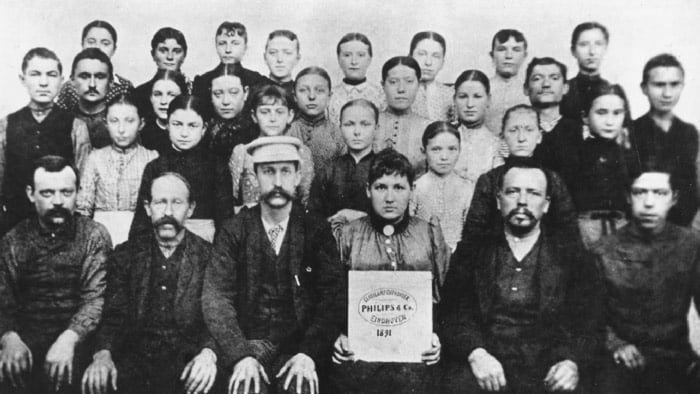Philips is a name synonymous with technological innovation and progress, having left an indelible mark on numerous industries over the past century. From its humble beginnings to its position today as a leading player in health technology, Philips has built an impressive legacy. Let's explore how the company transformed itself from a small Dutch enterprise to a global powerhouse in health and lighting solutions. Uncover the advanced capabilities of the Philips 5500 LatteGo review
Humble Beginnings: The Formation of Philips
The origins of Philips trace back to 1891 when Gerard Philips, alongside his father Frederik Philips, founded the company in Eindhoven, Netherlands. Initially focused on producing carbon-filament lamps, Philips faced significant challenges in its early years, battling financial difficulties and stiff market competition. Despite these struggles, their commitment to quality laid the foundation for Philips' transformation into a global electronics pioneer. Get a closer look at the features of the Philips 5400 LatteGo review
Early Innovations Set the Stage for Growth
By the early 20th century, Philips had emerged as a key player in the European lighting industry, thanks to its dedication to innovation and large-scale production. In 1914, Philips opened its Research Laboratory (NatLab), which became a hub for creativity and technological breakthroughs, setting the stage for the company to expand into new domains and lead in innovation. Compare these two machines side by side in the Philips LatteGo 5400 vs 4300 review
Entering the Radio Era
During the 1920s and 1930s, Philips made a significant move into radio technology, tapping into the growing consumer interest in broadcasting. The company began manufacturing radios in 1927, and by 1932, it had sold over a million units. This demonstrated Philips' keen ability to anticipate market trends and capitalize on emerging technologies. Discover the differences among these models in the Philips 3200 vs 4300 vs 5400 review
World War II: Resilience and Ingenuity
World War II posed immense challenges for Philips, including disrupted operations and considerable damage to facilities. However, the company demonstrated remarkable resilience. Key personnel were relocated, allowing crucial research to continue. Philips' adaptability during this difficult period led to contributions in wartime technologies like radar, underscoring their inventive spirit even in the face of adversity. Learn how these two models compare in the Philips 3200 vs 4300 review
Post-War Breakthrough: The Rise of the Audio Cassette
After the war, Philips embarked on a new era of consumer-focused innovation. In 1963, they introduced the compact audio cassette, which revolutionized the way people recorded and listened to music. The cassette's global popularity helped Philips cement its reputation as a leader in consumer technology, influencing the music industry for decades. See what sets these models apart in the Philips 3200 vs 5400 review
Redefining Music with the Compact Disc
Philips continued its tradition of innovation by partnering with Sony to launch the compact disc (CD) in the late 1970s. This invention transformed the music industry by providing a durable, high-quality format for digital audio. The launch of the CD showcased Philips' strength in forging strategic alliances and pushing technological boundaries that redefined entertainment. Get a detailed review of the Philips LatteGo 5400 review

Diversification into Electronics and Television
Throughout the latter half of the 20th century, Philips diversified further into consumer electronics, playing a pivotal role in the development of VHS technology and later the DVD, shaping the home entertainment experience. Their innovative products, such as the Ambilight TV in the 1990s, reinforced Philips' reputation as a trailblazer in consumer electronics. Discover the compact and efficient design of the Philips 3200 LatteGo review
Shifting Focus to Healthcare Technology
In the 1980s, Philips began pivoting towards healthcare technology, recognizing the immense potential in this sector. The company invested heavily in medical imaging, patient monitoring, and health informatics, ultimately emerging as a key player in the health technology space. Strategic acquisitions and innovative solutions have helped Philips build a robust portfolio aimed at improving healthcare outcomes. Dive into the advanced features of the Philips 4300 LatteGo review
Emphasizing Health and Lighting Solutions
In recent years, Philips has strategically shifted its focus away from traditional consumer electronics to concentrate on health technology and lighting solutions. In 2016, Philips separated its lighting division, which became Signify, allowing the company to focus more deeply on health technologies. This move aligned with the global trend of prioritizing health and well-being.
Dedication to Sustainability and Social Impact
Philips has shown a longstanding commitment to sustainability and corporate responsibility. The company has set ambitious targets, such as achieving carbon-neutral operations and embracing circular economy principles. These initiatives demonstrate Philips' dedication to environmentally conscious practices and societal well-being.
Adapting to the Digital Era
Philips has fully embraced digital transformation, using artificial intelligence (AI) and data analytics to enhance its product offerings and services. With an emphasis on connected care and intelligent health solutions, Philips is positioning itself at the forefront of a healthcare future shaped by digital innovation, aiming to improve patient outcomes through smart technologies.

Conclusion: A Legacy of Resilience and Forward Thinking
The story of Philips is a powerful reminder of what can be achieved through adaptability and an unwavering focus on innovation. From its origins in light bulb manufacturing to its current role as a health technology leader, Philips has consistently evolved to meet society's needs. The company's influence spans multiple industries—from changing how the world enjoys music to revolutionizing healthcare technology.
As Philips continues to innovate and tackle global challenges, its legacy stands as a testament to the enduring power of technological progress and commitment to societal improvement. The future holds immense promise, driven by the rich history and pioneering spirit that have defined Philips for more than a century.
